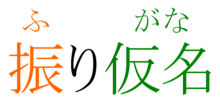Kanji
Kanji (漢字) source are the ideographic characters of the Japanese language. They are based on the Chinese Hanzi and to some degree are mutually readable, but there are some major differences as well. In fact, guessing the meaning of a kanji based on its Chinese meaning can be misleading.
The kanji do not convey the entire meaning of a word, but its base meaning. Its grammatical use is determined by the surrounding particles and the following kana determine its tense. Also, Japanese does not have a Kanji for every word, especially ones borrowed from English or other Western languages. Nevertheless, to understand the Kanji is at the heart of understanding the Japanese language, and if you cannot read the Kanji, at least at a basic level, the large numbers of homonyms in Japanese can cause much confusion.
Readings
A single Kanji can be read (pronounced) in many different ways, depending on its context. These readings are categorized into two groups - that of Chinese origin
It is often the case that a Kanji has more than one reading of Chinese origin. This is because the importing of Chinese letters (with their readings) did not occur just at one time from one region. To help figure out how to pronounce a kanji, kana is printed next to a kanji like in this example:
 The hiragana over the kanji tell you that this word should be pronounced ふりがな
The hiragana over the kanji tell you that this word should be pronounced ふりがな
When kana is printed next to a kanji, like above, it is called furigana.
Major readings
On yomi
It may be useful to note that in some Kanji databases, the on reading is written in Katakana instead of Hiragana.
Kun yomi
This reading generally will be written in Hiragana in Kanji lists.
Other readings
Nanori
The 康 read as やす (yasu; as in 徳川家康) and the 信 read as のぶ (nobu; as in 織田信長)are both written in 名乗り読み (nanori yomi).
Kanji Repetition
The 々, or ノマ (noma) symbol indicates the repetition of a Kanji. An example of a repetition is われわれ (wareware), which indicates "us" or "our group" and is written as 我々 instead of 我我, although they are both the same. The same is true with 人々 (ひとびと, people).
Learning Kanji
Further Reading
| Project: Introduction to Japanese |
| Previous: Kana — Kanji — Next: Pronunciation of Japanese |